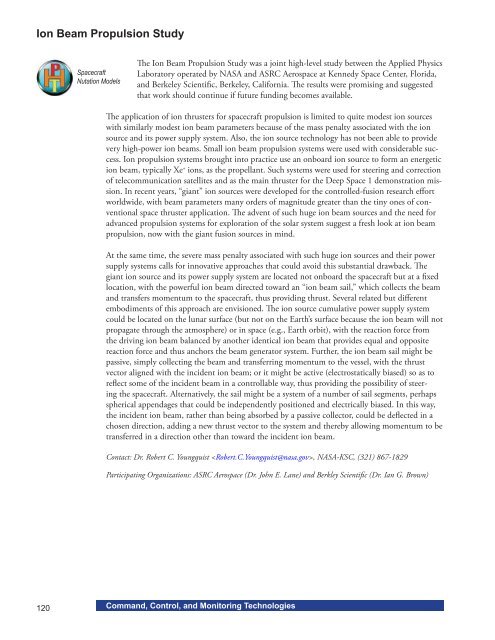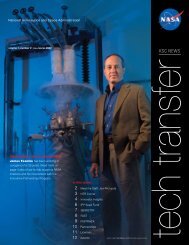2006-2007 - Kennedy Space Center Technology Transfer Office
2006-2007 - Kennedy Space Center Technology Transfer Office
2006-2007 - Kennedy Space Center Technology Transfer Office
- No tags were found...
Create successful ePaper yourself
Turn your PDF publications into a flip-book with our unique Google optimized e-Paper software.
Ion Beam Propulsion Study<strong>Space</strong>craftNutation ModelsThe Ion Beam Propulsion Study was a joint high-level study between the Applied PhysicsLaboratory operated by NASA and ASRC Aerospace at <strong>Kennedy</strong> <strong>Space</strong> <strong>Center</strong>, Florida,and Berkeley Scientific, Berkeley, California. The results were promising and suggestedthat work should continue if future funding becomes available.The application of ion thrusters for spacecraft propulsion is limited to quite modest ion sourceswith similarly modest ion beam parameters because of the mass penalty associated with the ionsource and its power supply system. Also, the ion source technology has not been able to providevery high-power ion beams. Small ion beam propulsion systems were used with considerable success.Ion propulsion systems brought into practice use an onboard ion source to form an energeticion beam, typically Xe + ions, as the propellant. Such systems were used for steering and correctionof telecommunication satellites and as the main thruster for the Deep <strong>Space</strong> 1 demonstration mission.In recent years, “giant” ion sources were developed for the controlled-fusion research effortworldwide, with beam parameters many orders of magnitude greater than the tiny ones of conventionalspace thruster application. The advent of such huge ion beam sources and the need foradvanced propulsion systems for exploration of the solar system suggest a fresh look at ion beampropulsion, now with the giant fusion sources in mind.At the same time, the severe mass penalty associated with such huge ion sources and their powersupply systems calls for innovative approaches that could avoid this substantial drawback. Thegiant ion source and its power supply system are located not onboard the spacecraft but at a fixedlocation, with the powerful ion beam directed toward an “ion beam sail,” which collects the beamand transfers momentum to the spacecraft, thus providing thrust. Several related but differentembodiments of this approach are envisioned. The ion source cumulative power supply systemcould be located on the lunar surface (but not on the Earth’s surface because the ion beam will notpropagate through the atmosphere) or in space (e.g., Earth orbit), with the reaction force fromthe driving ion beam balanced by another identical ion beam that provides equal and oppositereaction force and thus anchors the beam generator system. Further, the ion beam sail might bepassive, simply collecting the beam and transferring momentum to the vessel, with the thrustvector aligned with the incident ion beam; or it might be active (electrostatically biased) so as toreflect some of the incident beam in a controllable way, thus providing the possibility of steeringthe spacecraft. Alternatively, the sail might be a system of a number of sail segments, perhapsspherical appendages that could be independently positioned and electrically biased. In this way,the incident ion beam, rather than being absorbed by a passive collector, could be deflected in achosen direction, adding a new thrust vector to the system and thereby allowing momentum to betransferred in a direction other than toward the incident ion beam.Contact: Dr. Robert C. Youngquist , NASA-KSC, (321) 867-1829Participating Organizations: ASRC Aerospace (Dr. John E. Lane) and Berkley Scientific (Dr. Ian G. Brown)120 Command, Control, and Monitoring Technologies













